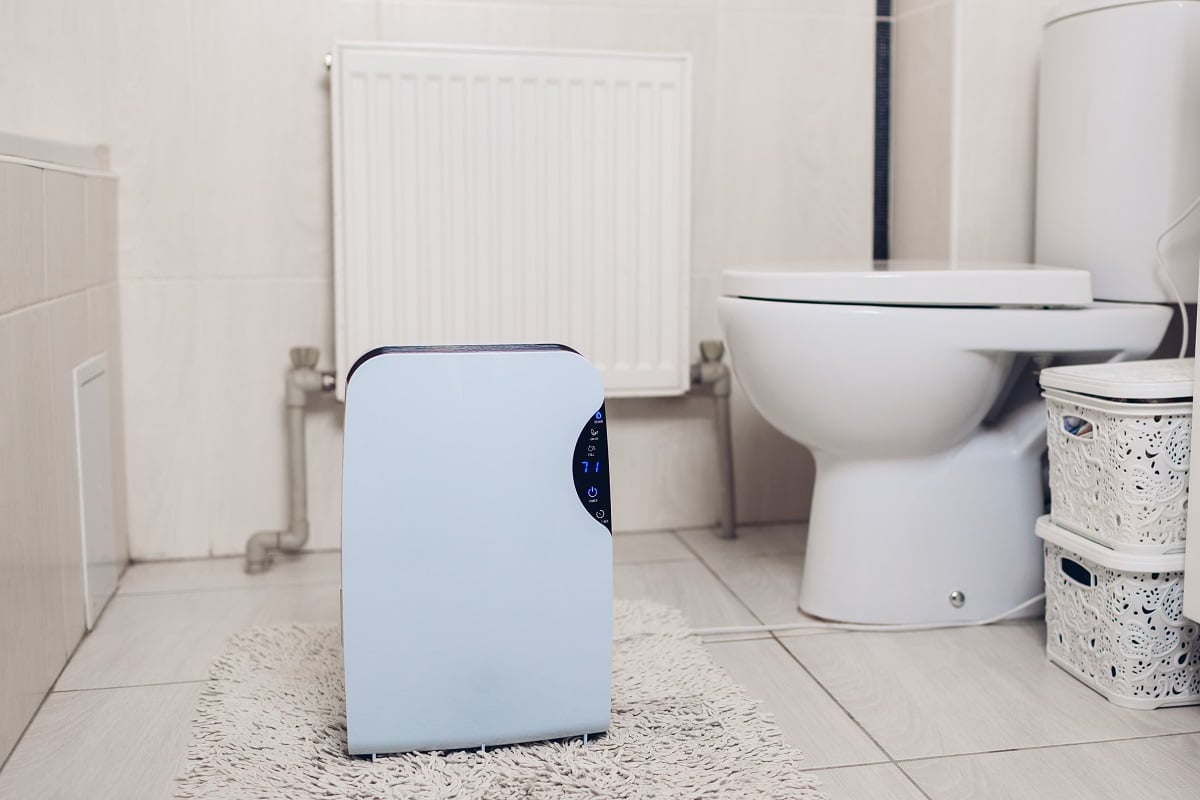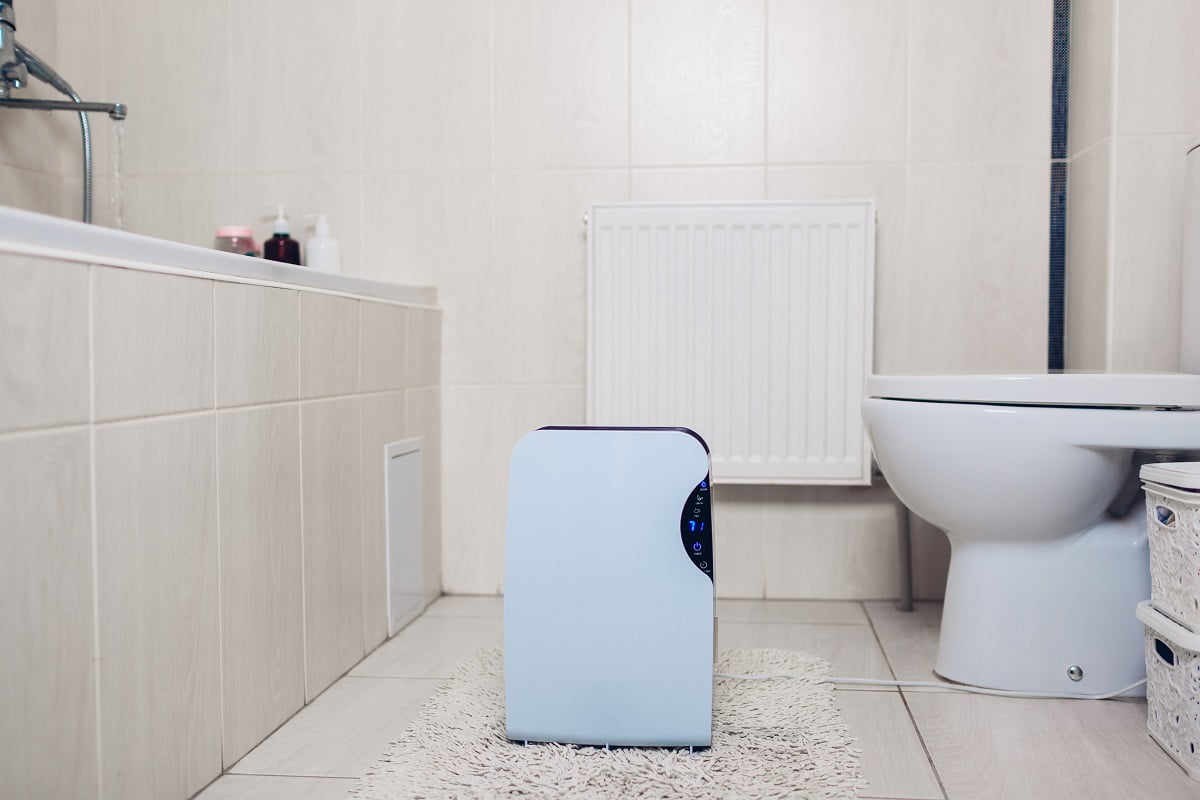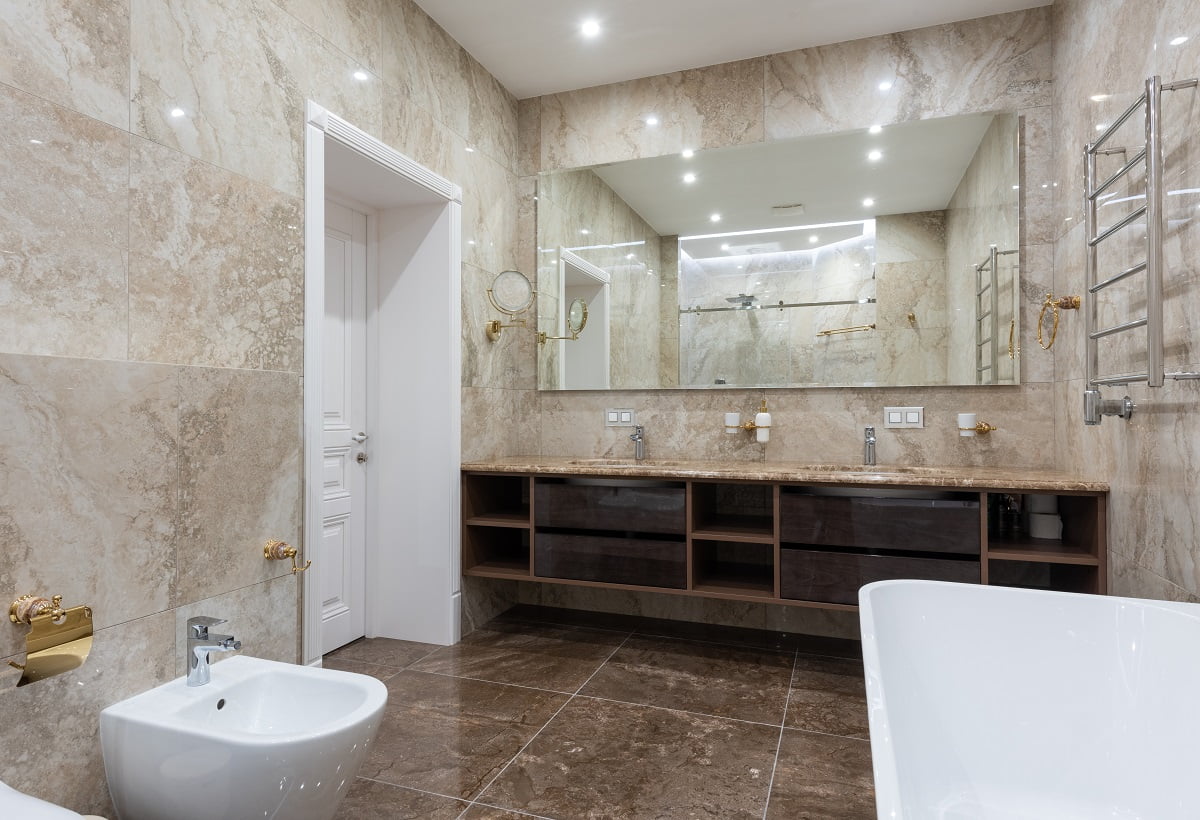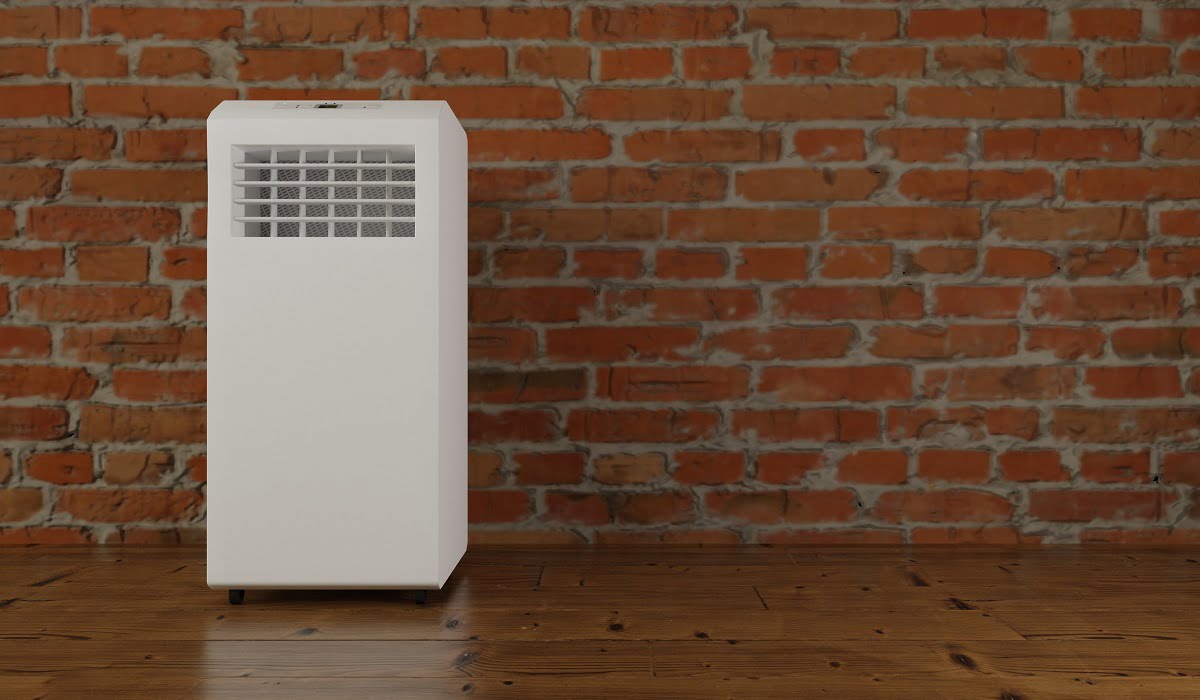When it comes to buying a new dehumidifier for the bathroom, you might feel overwhelmed since a lot of factors must be taken into consideration.

Nevertheless, you can simplify the search by asking the right question while choosing them. One of the most critical questions you must consider is, “What size dehumidifier is appropriate for my bathroom?”
Yes, you heard us right; size and capacity play a crucial role in choosing the suitable dehumidifier for your bathroom. For instance, a small dehumidifier will fail to get the job done if you have a massive bathroom with ample space.
Besides this, they are designed to absorb a specific moisture unit within a day. This unit of moisture is known as PPD or pint per day. Therefore, choosing the right model requires you to measure the amount of humidity in your bathroom.
However, other factors can influence the model you require for your bathroom. On that note, we have compiled this guide so that you find the appropriate dehumidifier for your bathroom.
How Do I Select The Right Size Dehumidifier

As we have mentioned earlier, two important factors play an important role in deciding which dehumidifier is ideal for your bathroom.
In this section, we will focus on different room sizes and which dehumidifier will be appropriate. Before we begin, you will need to measure the area of your bathroom in sq. ft. measurement. You can follow these steps to measure your bathroom:
- Begin the process by measuring the length of the bathroom in feet unit
- Repeat the same process while measuring the width of the bathroom
- Multiply both of the measurements to get the area in sq. ft.
In addition, some owners prefer to move the dehumidifier around their house. In this situation, we recommend measuring the largest room in your house so that you can purchase a large dehumidifier. Besides this, you can use the following tips to decide which dehumidifier is compatible with your bathroom.
1. Large Spaces ( Approx 2,500 Square Feet)
In case you are living in an area that experiences high humidity, you might require a whole-house dehumidifier. Moreover, it can be ducted to the HVAC system of your house, making it easy to install. You can use a whole-house dehumidifier to prevent mold and mold odor in your room.
Initially, you might view this as an expensive investment since whole-house dehumidifiers are more costly than portable units. However, it is manufactured to cover large areas of 3000 sq. ft. or more. This makes it a cheaper alternative since you don’t need to purchase multiple models for your house for a long period.
Apart from this, it can be used to enhance the efficiency of your AC since it can provide cool and dry air, which is soothing for the skin.
2. Small Spaces (Approx 100 To 250 Sq Ft)
When it comes to small rooms, it is tough to install a 70-pint dehumidifier since it takes up most of the space; therefore, it leaves less space for moving around. Besides this, it can create a lot of noise while drawing moisture from the air. Hence, we recommend using a mini dehumidifier.
Generally, a mini-humidifier is designed to cover a space of 100 to 300 sq. ft. Therefore, it doesn’t create any noise and effectively balances the moisture level in your room. In addition, it is ideal for small bedrooms, nurseries, and children's rooms since it is easy to move around and compact.
Nevertheless, it does have one minor drawback, which is it can’t retain excess moisture due to its small water tank.
Most brands nowadays design mini dehumidifiers to turn off once the reservoir is full automatically due to its small pint capacity. This ensures that the device doesn’t get spoiled due to an overload.
3. Cool Environment
For those who live in a cold region that experiences cold weather throughout the year, we suggest not purchasing a dehumidifier since it will not work. In fact, the water in the reservoir can end up freezing, which causes it to waste more energy than usual. Eventually, the unit can get damaged internally, and you might require to spend a lot of money to repair it.
Instead of using a regular dehumidifier, you can opt for a desiccant dehumidifier to help you with the humidity problem. Desiccant models have a fitted rotor filled with sheets as the main component. These sheets are made from desiccant material which makes them extremely porous and highly absorbent.
Therefore, as soon as the fan draws the air into the unit, it passes through the rotor sheets, and the moisture is absorbed.
Notably, a desiccant dehumidifier is quieter since it doesn’t require a compressor. Furthermore, it offers better energy efficiency while keeping your room dry.
4. Hot Environment
For those who are living in the southern part of the world, you will require a larger dehumidifier since the humidity levels will not go lower than 70%. As such, a refrigerant model is ideal since it can extract high moisture levels from the air. Moreover, it works in hotter temperatures, whereas desiccant models fail to draw moisture from the air.
The refrigerant models draw moisture from the air through the fans and convert them into cool air through coil sets. Besides this, the refrigerant liquid circulating through the model in the form of gas plays a very important role in keeping the air cool and retaining moisture. Hence, you balance the moisture levels at your place while it keeps the rooms cool.
However, refrigerant models are usually bulky, which makes it hard to move around. Therefore, you should only purchase them if you have plenty of space.
How To Choose The Right Dehumidifier Capacity Model To Absorb Excess Moisture
As we discussed earlier, area coverage is one of the most important factors to consider while picking a dehumidifier. In the same way, you must check the humidity levels since it can greatly influence the model you will require. Most owners use humidity meters to check the humidity levels in the house, but this is not needed.
Keeping this in mind, here are a few key signs you should consider while selecting the different types of dehumidifier capacity.
A. Moderately Damp Spaces
When it comes to moderately damp areas, you don’t need a bulky or large-capacity unit since it has low moisture levels. Therefore, it doesn’t require too much energy to extract moisture from the air. On that note, we recommend using a 30-pint dehumidifier for a large space of 2,500 square feet. In fact, this unit can easily absorb all the moisture without creating too much noise.
On the other hand, smaller areas ranging from 500 square feet to 1000 square feet will require a ten or 20-pint dehumidifier. Moreover, it is designed to be extremely compact so that you can store them in a small corner without any difficulty.
B. Very Damp Spaces
If you notice damp spots all over the place, it is a clear sign that your house requires a higher capacity unit to absorb all the humidity and bring down the humidity levels. Large areas ranging from 1000 to 2500 sq. ft. will require a 50-pint dehumidifier to get the job done. Moreover, it can draw out humidity without getting overwhelmed by excess power consumption.
In contrast, smaller areas with high humidity will require a 30-pint unit. Since it will be compact, you don’t have to worry about storing them.
C. Wet Spaces
While checking the moisture levels, if you notice wet spots in the entire house, you will require a strong humidifier to absorb the excess humidity from the air and the environment. Hence, we suggest using a dehumidifier model with an absorption rate of 50 to 70 pints. A 70-pint unit can easily remove all the moisture from your house in no time.
However, they tend to be a bit noisy; therefore, you should only keep them on for a short period.
In case you are living in a smaller space that ranges from 500 to 1000 sq. ft., we recommend a 50-pint unit. It might look bulky for a small space, but it will get rid of the excess moisture while preventing mildew and molds from occurring.
D. Extremely Wet Spaces
Lastly, if you notice standing water in different parts of your room, we recommend getting an LGR dehumidifier. This unit is specifically designed to get rid of the moisture while it helps to dry the place and prevent water damage. However, LGR units are extremely bulky and expensive.
Instead, you can opt for a 70-pint dehumidifier for large spaces and a 50-pint unit for small spaces. Both of these units can reduce the moisture levels provided you let them run for a long period. If you are wondering, “where to place a dehumidifier in a bathroom?” we recommend installing it far away from a tap or water source.
Other Factors To Consider While Choosing A Dehumidifier

Apart from room size and humidity conditions, several other factors can greatly influence the choice you make while selecting a dehumidifier. In addition, different households may not have the same factors and weather conditions, so you must carefully examine each of these factors before making your final choice.
Here are a few examples you must look out for:
1. Pets
If you are a pet owner, it is crucial to keep the humidity levels low since dogs, and other furry pets tend to feel extremely hot in a high humidity climate. Moreover, if your dog has thick fur, it will take them a long time to cool down, which can cause them to develop heat strokes and other medical problems.
On that note, we recommend using a whole-house dehumidifier or a larger humidifier since it will reduce the excess moisture in the air. This will ensure your furry friends have a comfortable space to live and move around. In case you are short on money, you can use cat litter as a dehumidifier since it works well in absorbing moisture.
2. AC
Having an air conditioning unit can significantly enhance a dehumidifier's performance since both home appliances work similarly. If you like to use the AC often during the summer, we recommend getting a small dehumidifier to accompany it. In fact, it will remove any moisture remaining in the air while using less energy.
By working together, these home appliances can create a cool and dry environment that will soothe your mind and help you to feel comfortable while relaxing. Nevertheless, you must ensure to turn off the unit as soon as the room gets cold.
3. Humid Climate
In case you are living in a region that experiences a humid climate throughout the year, the relative humidity will be slightly higher indoors. One of the most effective ways of choosing the right unit for this type of situation is by adding ten pints to the model you prefer. For instance, if you were thinking of using a 50-pint unit, we suggest using a 60-pint unit instead.
This will allow the dehumidifier to remove the excess humidity present in your room.
4. Nearby Dryer And Washer
When it comes to small apartments and townhouses, the dryers and washers are usually placed near your living space, which can cause the humidity to spike up in your house. Therefore adding an extra 5 pints to the model you are planning to choose will compensate for the excess moisture present in the air.

How Big Of A Dehumidifier Do I Need For My Bathroom FAQs ?
Is It Better To Purchase A Bigger Dehumidifier For Your Bathroom?
Technically speaking, there is no harm in purchasing a bigger dehumidifier for a small bathroom since it will work faster to draw out all the moisture from the air. Hence, you can save energy since you don’t need to keep it on for a long time.
However, a bigger dehumidifier tends to be noisy and a lot more expensive.
Which Size Dehumidifier Will Be Ideal For The Basement?
While choosing the appropriate size dehumidifier for your basement, you must consider two important factors, which are as follows:
- Area of the basement
- Level of humidity
For instance, most basements tend to be damp; therefore, choosing a large-capacity dehumidifier will ensure the job is done. Besides this, you must calculate the area of the room in sq. ft. since it will help you to determine if the room is small or big. This will help you choose the right dehumidifier for that space.
Do You Require A Dehumidifier For Each Room?
Ideally, you should install a dehumidifier in each room if you live in a humid region, but you must take into account two factors. Firstly, if you live in an apartment and all the rooms are close to each other, you can use a single large dehumidifier to draw air from all the rooms. Just make sure to keep the entrance of the rooms open so that the dehumidifier can access the rooms easily.
Secondly, if you live in a multi-story building, you must purchase a whole-house dehumidifier for each story in the building. You can opt for an easy-to-carry dehumidifier since it is extremely portable and easy to carry around.
Is There Any Harm In Using A 70-Pint Dehumidifier When Your Room Requires 30-Pints?
You can install a 70-pint dehumidifier for your room since it will absorb all the moisture in the air in no time. Moreover, you can save energy since you don't need to turn it on for the whole day.
However, it does make a lot of noise if you install it in a small area. Nevertheless, you can ignore this drawback if your primary goal is to save more energy and money in the long run.

How Big Of A Dehumidifier Do I Need For My Bathroom Final Words
With that, we have come to the end of our extensive guide. Before logging off, we want to summarize a few points to make your search for a dehumidifier easy and simple.
Firstly, you should always consider the size of a bathroom since all brands design their dehumidifier for a specific space and size. You can measure the area of your bathroom by multiplying the width and length of the space.
Apart from this, you should consider the level of humidity in your bathroom. If your bathroom is constantly wet, you will require a dehumidifier with a moisture absorption rate of 50-pint to 70-pint.
Checkout our previous article on how to properly use colored pencils to gain information on painting and sketching. This article is off topic for people searching for the right dehumidifier for bathroom, but can be helpful for other uses.
That said, it’s a wrap. See you next time!
